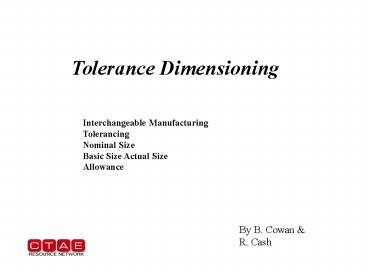Tolerance Dimensioning - PowerPoint PPT Presentation
1 / 20
Title:
Tolerance Dimensioning
Description:
Basic Size Actual Size ... Arial Times New Roman Calibri Office Theme AutoCAD R13 Drawing Slide 1 Slide 2 Slide 3 Slide 4 Slide 5 Slide 6 Slide 7 Slide 8 Slide ... – PowerPoint PPT presentation
Number of Views:526
Avg rating:3.0/5.0
Title: Tolerance Dimensioning
1
Tolerance Dimensioning
Interchangeable Manufacturing Tolerancing Nominal
Size Basic Size Actual Size Allowance
By B. Cowan R. Cash
2
Mass Production
Interchangeable manufacturing allows parts made
in widely separated localities to be brought
together for assembly. That the parts all fit
together properly is an essential element of
mass production. Without interchangeable
manufacturing, modern industry could not exist,
and without effective size control by the
engineer, interchangeable manufacturing could not
be achieved. Dimensions should be given to as
large a tolerance as possible without interfering
with the function of the part to reduce
production cost. Manufacturing to close
tolerance is expensive.
3
Basic Dimension
Toleranced Dimension
4
Unilateral Tolerance
Unilateral Tolerance allows variation in only one
direction. From basic size.
Bilateral Tolerance
Bilateral Tolerance allow variation in either
direction from basic size.
5
Other Methods Of Positioning and Indicating
Tolerances Bilateral and Unilateral
6
Specify Tolerance By Note
NOTE All dimensions Plus or Minus 1/16 Inch
7
Tolerance
8
Tolerance
9
Glossary Of Terms Mating Parts are parts that
fit together within a degree of
Accuracy. Tolerance is the difference between
the limits prescribed for a single
part. Allowance is the tightest fit between two
mating parts. Nominal Size is an approximate
size that is usually expressed with common
fractions. Basic Size is the exact theoretical
size from which limits are derived. The basic
size expressed as a decimal
10
Shaft
Tolerance is the difference between the limits
prescribed for a single part. The Tolerance for
the Shaft is .002
Hole
11
Allowance is the tightest fit between two mating
parts. The smallest hole and the largest shaft.
The Allowance for the Shaft and Hole is .003
12
2 1/2 Inch Shaft
Nominal Size
Basic Size
13
Type of fits between mating parts
when assembled. Clearance Fit is a fit that
gives a clearance between two assembled mating
parts. Interference Fit is a fit that results in
an interference between the two assembled parts.
The Shaft is larger than the hole. Transition
Fit can result in either an interference fit or a
clearance fit. The shaft can be either larger or
smaller than the hole. Line Fit can result in a
contact of surfaces or a clearance fit
between shaft and hole. Page 389
14
American National Standard of Limits and Fits RC
Running or Sliding Clearance Fits - Intended
to provide a similar running performance with
suitable lubrication allowance. Piston in a
car. LC Locational Clearance Fits - Intended
to determine only the location of the mating
parts. FN Force Fits or shrink fits
constitute a special type of interference fit,
normally characterized by maintenance of
constant bore pressure throughout the range of
sizes. Page 393
15
Example Specify a RC3 Fit for the 1 1/4 Inch
Shaft and Hole See Page a25 in the Appendix
16
Basic Size 1.2500
Nominal Size Range Hole Shaft 1.19 -
1.97 1.0
-1.0
-0 -1.6
17
Nominal Size Range Hole Shaft 1.19 -
1.97 1.0
-1.0
-0 -1.6
Multiply by .001
Nominal Size Range Hole Shaft 1.19 -
1.97 .0010
-.0010
-0 -.0016
18
Nominal Size Range Hole Shaft 1.19 -
1.97 .0010
-.0010
-0 -.0016
Add or Subtract From Basic Size To Calculate
Tolerance.
19
Nominal Size Range Hole Shaft 1.19 -
1.97 .0010
-.0010
-0 -.0016
Hole 1.25 .0010 1.2510 1.25 - 0 1.2500
Shaft 1.25 - .0010 1.2490 1.25 - .0016 1.2484
20
Hole 1.25 .0010 1.2510 1.25 - 0 1.2500
Shaft 1.25 - .0010 1.2490 1.25 - .0016 1.2484

